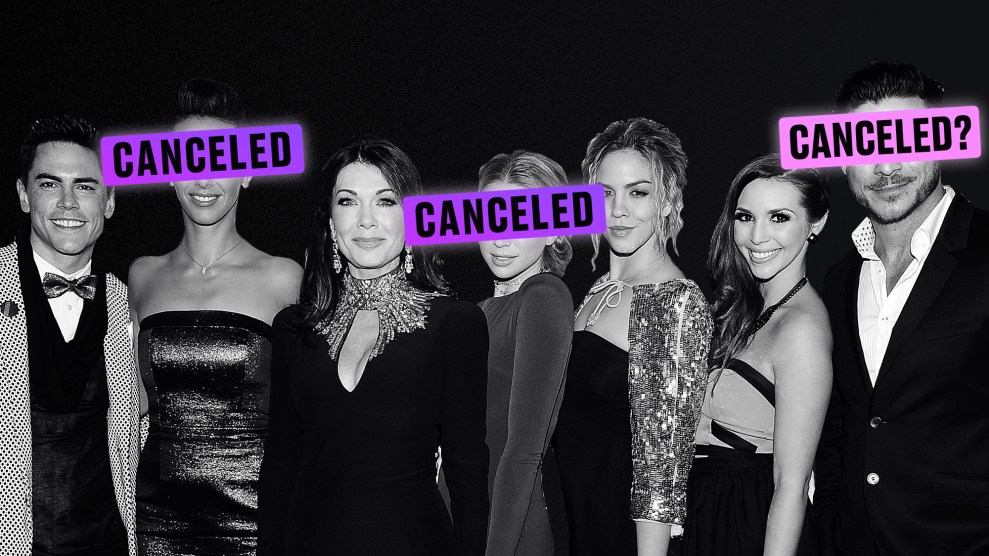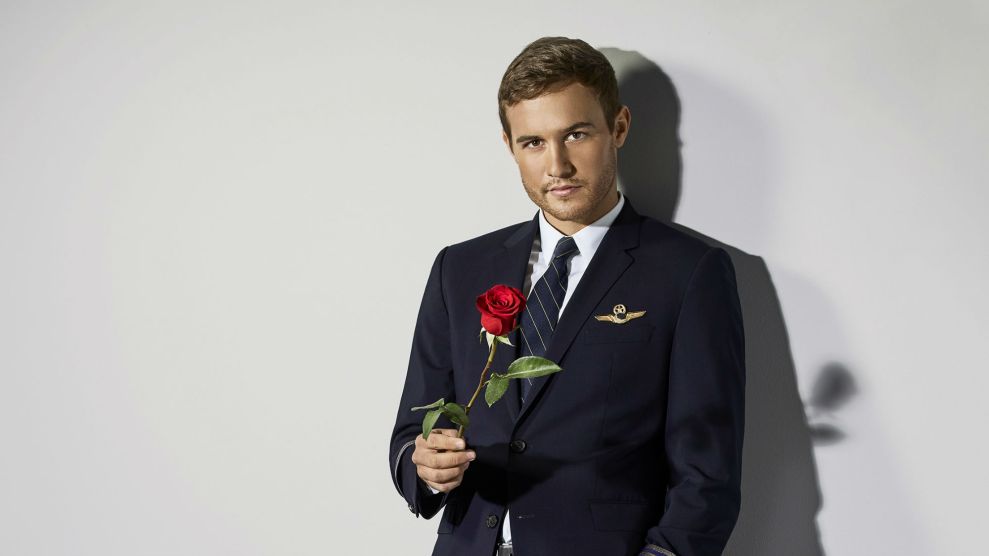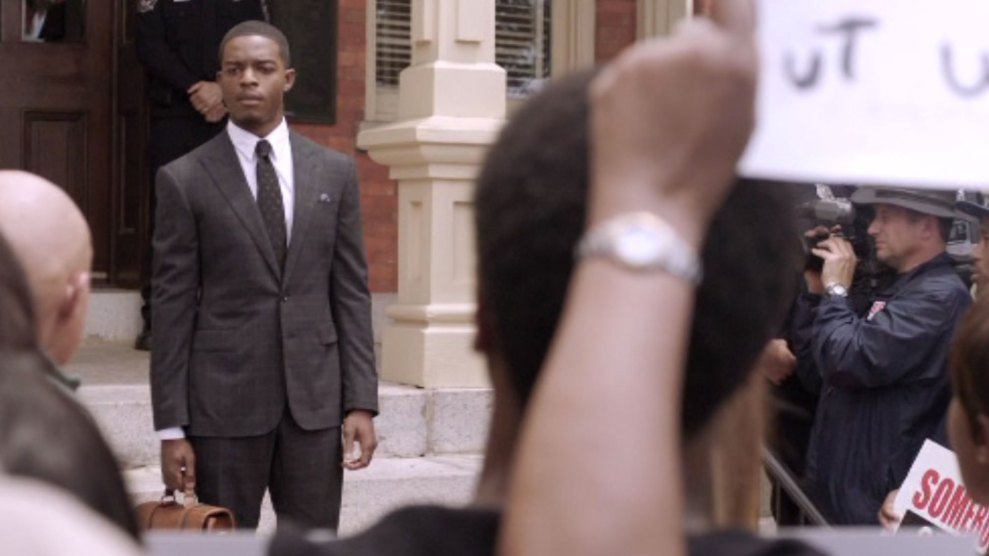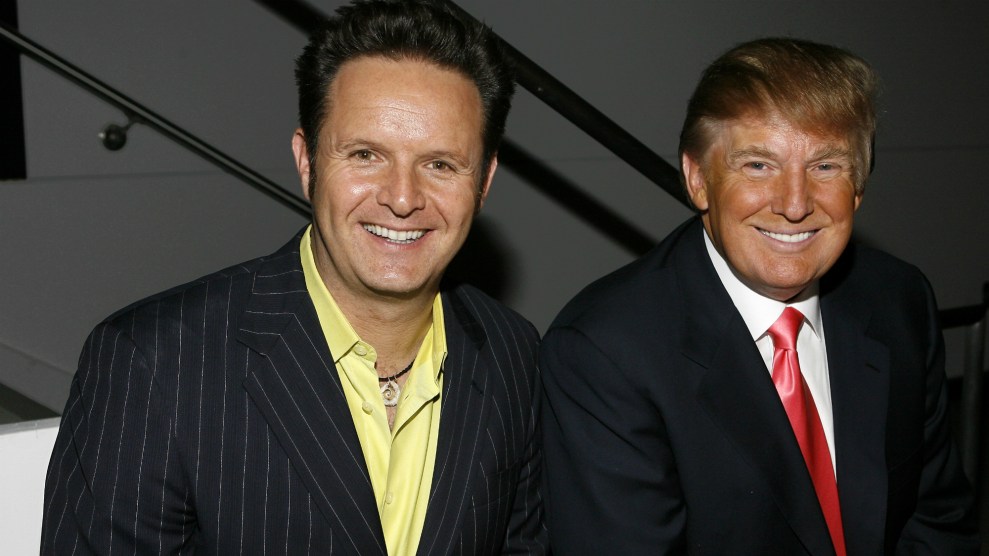
Mother Jones illustration; Jason LaVeris/Getty
On June 12, almost three weeks after the police killing of George Floyd sparked massive protests for racial justice throughout the country, the long-running reality show The Bachelor announced that Matt James would become the first Black bachelor on the show’s 25th season. The announcement came 18 years after the creation of the show, three years after Rachel Lindsay became the first Black bachelorette and repeatedly called out the franchise for systemic racism, two years after Bachelor creator Mike Fleiss called his own audience Trumpishly racist, and five days after a Change.org campaign—which is now 135,000-plus signatures strong—called for anti-racist changes within the franchise. It appears that the seismic national reckoning with racial injustice has finally reached the cosseted world of reality TV.
The awakening at The Bachelor is the picture of calm in comparison to the real reality-show drama that unfolded in June at Vanderpump Rules, a Bravo spinoff from The Real Housewives of Beverly Hills. Vanderpump Rules follows a group of aspiring mactors—that’s models/actors—who work in Lisa Vanderpump’s empire of bars and restaurants in Los Angeles. The cast members have spent the past eight seasons fighting, partying, hooking up, breaking up, cheating, gossiping, and getting so drunk that you can feel their hangovers through the screen. They have also served countless goat-cheese balls and pump-tinis to the residents and tourists of West Hollywood, including celebrities like Jennifer Lawrence (who is also a huge fan of the show).
I’m with Jennifer. I was one of the 1.1 million people who tuned in to the eighth season of Vanderpump Rules (VPR) this year, the culmination of my loyalty over all eight seasons, some episodes of which I’ve watched multiple times. In fact, I’ve been on record calling VPR “the greatest reality show of all time.” Sure, other shows let me vicariously experience a California sun-dappled life filled with day-drinking and botox and photoshoots. But Vanderpump Rules is special because the drama is real. The show follows a group of friends and lovers with interpersonal dynamics as complicated as a Tolstoy novel and as soap-operatic as the original Dallas. Coming from someone who’s watched a lot of reality TV, trust me, it is *chef’s kiss* reality gold.
But these entertaining mactors of West Hollywood were not exempt from the historic national reckoning with systemic racism and racial injustice. In mid-June, all 19 cast members—a majority-white group—posted their support of Black Lives Matter on social media. Then four of them were called out for personal histories of racist behavior, and they were fired. Two were not just cast members; they were what passed for the supernovas in the Vanderpump constellation, having been with the show for all eight seasons.
It seems the days of seemingly heartfelt Instagram apologies presuming to make up for egregious behavior are numbered.
Like all American institutions, reality TV has a history of racism that predates cancel culture. Rooted in documentary film, the genre as we know it today—unscripted but heavily produced, peppered with confessionals, fueled by booze and beautiful people—was introduced to mass audiences in 1992 with MTV’s The Real World, which, unlike its successors, intentionally cast people from many cultures and racial backgrounds. The Real World has been criticized for tokenizing racially, sexually, and regionally diverse groups, but it also had a social mission rooted in the multiculturalism of the 1990s and gave a platform to voices that had been sidelined in the mainstream media.
In the first decade of the 2000s, reality TV shows exploded onto the screen with the appearance of Big Brother, Survivor, American Idol, and The Simple Life. While most early reality shows filtered new casts in and out every season, around 2005 MTV’s Laguna Beach: The Real Orange County, E!’s Keeping Up with the Kardashians, and MTV’s Jersey Shore successfully adopted more of a docuseries style that focused on interpersonal relationships within groups of friends, families, and lovers over the course of multiple seasons. These shows usually glorified extreme wealth, partying, and problematic behavior that stoked drama and kept viewers coming back for more.
Bravo hit the jackpot in this vein with the 2006 launch of its Real Housewives franchise, which follows the lives of wealthy women in cities around the United States as they attend charity events, go on lavish vacations, host dinner parties, engage in elaborate beauty rituals, and fight fight fight with husbands, ex-husbands, soon-to-be-ex-husbands, boyfriends, best friends, and service personnel. Bravo’s brand became affluence, glitz, glamor, and venal conflicts. The franchise spread from the original Real Housewives of Orange County to eight other cities and birthed spinoff shows like Vanderpump Rules. Bill Langworthy signed on to be executive producer of Vanderpump Rules after one season on The Real Housewives of Orange County.
When it comes to race, The Real Housewives are segregated. The casts in Orange County, Beverly Hills, Dallas, New York, and New Jersey are almost entirely white. There have been two women of color in all those five cities combined after over a decade of filming. The franchise also expanded to Atlanta and Potomac, Maryland, where the casts are almost entirely Black. In a comment to the New York Times, a spokesperson said the lack of diversity in Bravo’s shows was due to the fact that the “docuseries follow groups of friends who are organically connected, often through long, pre-existing relationships but in some cases only casually through a wider social circle or six degrees of separation.” In other words, the racism isn’t Bravo’s problem. It’s America’s reality.
Bravo’s lack of diversity is part of the vast ecosystem from which these shows emerge. Bravo is essentially a platform for selling advertisements. In the case of Vanderpump Rules, brands like Procter & Gamble—the same company that’s now calling on white people to “use your power” to combat racism—have bankrolled the cast for years, essentially subsidizing them to behave in ways that now justify firing them. Are these “woke” commercials from huge brands—many of which have a long and deep history of perpetuating racism—just a form of crisis communications or are they a genuine reckoning with changing times? In an industry in which Black people have been misrepresented, ridiculed, tokenized, and just straight-up absent for years, do the firings of four cast members signal any meaningful progress?
In the first season of Vanderpump Rules, we met three best friends: Stassi Schroeder, Kristen Doute, and Katie Maloney-Schwartz, and Jax Taylor, Tom Sandoval, and Tom Schwartz, their three respective boyfriends and also best friends. Even though only one of the three couples remains together, these six people and their long, deep, tormented, drama-filled relationships have anchored the show for eight seasons. A typical episode of Vanderpump Rules is cut like a dramatic series, with A, B, and C plotlines. For instance: Jax tries to win Stassi back by getting her name tattooed on his arm. Tom Schwartz tries to get a job at the Vanderpump restaurant SUR, but Lisa Vanderpump rejects him because he’s dating Katie. Tom Sandoval and Kristen try to improve their relationship by building a coffee table together. Stassi gets mad at Scheana for bad-talking her to Lisa Vanderpump behind her back.
In the fourth season of this mix appeared Faith Stowers as a new server and best buds with the new hostess Lala Kent. Stowers’ arrival marked the first Black core cast member on Vanderpump Rules. Kent was courted by multiple men on the show while Stowers’ main interaction with men was when the two Toms gave her a hand-me-down couch. Kent was attacked by the women for taking her bathing suit top off and swimming half naked near their boyfriends, while Stowers, who also took her top off, was essentially ignored. Kent got confessionals—which translates into more screen time. While Kent’s star rose, Stowers pretty much faded into the background.
Stowers’ Vanderpump Rules contract was not renewed after that one season. Stowers returned to the center of the drama on the sixth season when she and Jax Taylor had an off-camera affair when Taylor was in a relationship with his now-wife, Brittany Cartwright. She was not part of the show then, but Stowers was skewered by the women on Vanderpump Rules, who attacked her with a vehemence that was somewhat surprising given that Jax Taylor cheated on his girlfriends all the time. Now, five years after her appearance on the show, after a stint on the first season of MTV’s The Challenge and Ex on the Beach, Stowers was interviewed by Floribama star Candace Rice on Instagram Live. In response to a question from a viewer about racism displayed by Stassi Schroeder and Lisa Vanderpump, Stowers explained: “I was the only Black person on the show. It was a lot.”
“A lot” is an understatement. She described how Stassi Schroeder and Kristen Doute had reported her to the police after they had seen photos in a 2017 article in the British tabloid Daily Mail of a Black woman who went to a Hollywood party, drugged men, and stole their watches, cash, and jewelry. The woman was still at large. Most important, she was not Stowers. “She looked very, very light-skinned and had these different, weird tattoos” Stowers told Candace Rice. “They thought it was me because it was a Black woman with a weave.” Schroeder and Doute called the police and reported that Stowers had committed the crimes. Jax Taylor also piled on, making a loosely veiled accusation on Twitter that Stowers was stealing cars and AWOL from the military.
In a 2018 episode of the Bitch Bible podcast, Schroeder recounted the event from her perspective: “We are like, we just solved a fucking a crime,” she said. “We start calling the police. The police don’t give a fuck. It’s really hard to get in touch with the police unless it’s an emergency.” Doute tweeted something to a similar effect in April 2018. The police ignored their bogus charges, Schroeder and Doute remained core cast members, and the entire incident probably would have remained buried were it not for the timing. The interview with Candace Rice took place on June 2 when the world was exploding with demands for racial justice on the heels of a white police officer killing George Floyd on May 25.
Stowers’ instagram interview blew up. An instagram account called Accountability4Stassi collected all of Schroeder’s racially insensitive actions, including a clip from a now-deleted 2017 episode of her podcast in which she criticized the #OscarsSoWhite movement, saying, “I’m like, really sick of everyone making everything about race—I’m kind of over it.” Photos of Schroeder dressed as “Nazi Chic” with Doute dressed as “Tupac Chic” started circulating. In an interview with AfterBuzz TV on June 11, Stowers said that Cartwright had also allegedly called her a “nappy-headed hoe” following the cheating scandal between Stowers and Jax Taylor.
The retribution extended beyond social media. Within a week of the June 2 interview Schroeder and Doute were dropped by their publicists and by all of their brand sponsors, and fired from Vanderpump Rules. Max Boyens and Brett Caprioni, who were both new cast members in the most recent season, were also let go after old tweets in which they used racist epithets emerged last January. Back then, they were acknowledged by the show’s executive producers and ignored. Boyens tweeted in 2012 that the n-word is his favorite word and said he wanted to punch Asians “in the suck hole.” Boyens later explained on Instagram that he is “BLACK” and wouldn’t have to say he’s “a quarter black” if people would just believe him, but he “didn’t express [he] was black when the tweets came out because [he] didn’t want to justify them.” Caprioni’s tweets date from 2011 and also use the n-word.
Coincidentally, June 2 was also a Vanderpump Rules reunion episode. Andy Cohen, the executive producer of the Real Housewives franchise and public face of Bravo on Watch What Happens Live, asked Boyens and Caprioni about the tweets. They both gave solemn apologies. Lisa Vanderpump said she forgave them (though how this became Lisa Vanderpump’s offense to forgive I have no idea), and it seemed like it would all pass as water under the bridge.
Except, the Stowers interview dropped that night. Bravo decided to appear tough on racism and fired the four of them. Lisa Vanderpump released a statement saying, “I love and adore our employees and I am deeply saddened by some of the lack of judgment that has been displayed.” Andy Cohen, who has been doing interviews with Black Real Housewives cast members about racism, said he “absolutely support[s] Bravo’s decision. I think it was the right decision.”
But these reality shows are not just stages for a few exhibitionistic cast members. There is a large infrastructure of advertisers, producers, showrunners, story editors, publicists, and network executives supporting them. And while firing some prominently offensive cast members may appear to address the problem, it doesn’t address the root causes. I reached out to a veteran Bravo producer, who asked to remain anonymous to avoid serious retributions for breaking their nondisclosure agreement. They told me that Bravo’s target audience is semiprofessional women in their 20s to early 40s and gay men.
“Were we asked as Bravo employees to cater to a certain demographic and marginalize people of color?” they said. “Yes. Because it didn’t fit the brand.” They told me that on an early season of Vanderpump Rules there were two major storylines involving people of color; both got cut because they weren’t “marketable,” which was in keeping with the instructions to producers and editors to “cut for our audience.” The producer recounts not being allowed to include hip-hop music cues for the club scenes because it was “not the tone for the show.”
The cast members who appeared on the show were given the spotlight, incentivized with more screen time, and praised for having no filter while saying deeply troubling things. The producer said that even more offensive comments than the ones that have come into public view recently hit the cutting-room floor over years of filming. “We have to make them seem human,” they said. “We cut out that shit to make them seem not like sociopaths and relatable…We have to think about them like characters.” The producer notes that there are people of color with prominent roles on Bravo’s crew. There are also many people of color working at Lisa Vanderpump’s restaurants. And yet, season after season, the cast of Vanderpump Rules are almost exclusively white.
Stowers is happy about the firings. She says that Bravo did the right thing and showed that they cared, though Stowers and Billie Lee are both asking that Jax Taylor get fired too for his racist and anti-trans behavior. Stowers told ET Canada, “I’m seeing change, and that’s what this whole thing is about.”
Well, yes. Accountability is important. Zero tolerance policies in the workplace for sexism, racism, or any other kind of harassment is a long-overdue step forward. And for reality TV stars, whose fame, power, and lucrative paychecks come from exposing all aspects of their existence, their lives are their jobs. Meanwhile, brands are going into overdrive to post their support for racial justice and Black Lives Matter, and everyone with a social media account seems to be using this moment to virtue-signal.
Schroeder, Doute, Boyens, and Caprioni are all being punished for things they did years ago and behavior that’s been out in the open for eight seasons. Boyens’ and Caprioni’s tweets were uncovered in January. Schroeder openly bragged about calling the cops on Stowers back in 2018. When it comes to reality TV and social media, the line between authenticity and appearance, reality and performance, has never been fuzzier. “Wokeness” has the potential to awaken hearts and minds, whether it comes from a genuine place or not. These people were not cast in spite of their problematic behaviors, including racial profiling, slut-shaming, and all the other judgmental prejudices that ooze out of our mainstream white heteronormative culture. They were cast because of them.
I like reality TV for a lot of the same reasons that I like journalism. I’m nosy. I like to learn about people’s lives and how people live. On a good day, this kind of work fosters understanding and compassion, a sense of human solidarity. On a bad day, we point fingers and say, “Look at those beautiful-pitiful-hilarious-disturbing people over there.” And that’s exactly why I’m uneasy about what is likely to follow this most recent spate of firings. Sure, reality networks will continue to get called out for racism and lack of representation, and people will continue to get fired. Meanwhile, viewers can relax and judge all those racist people over there. After all, it’s much easier than looking in the mirror.

















